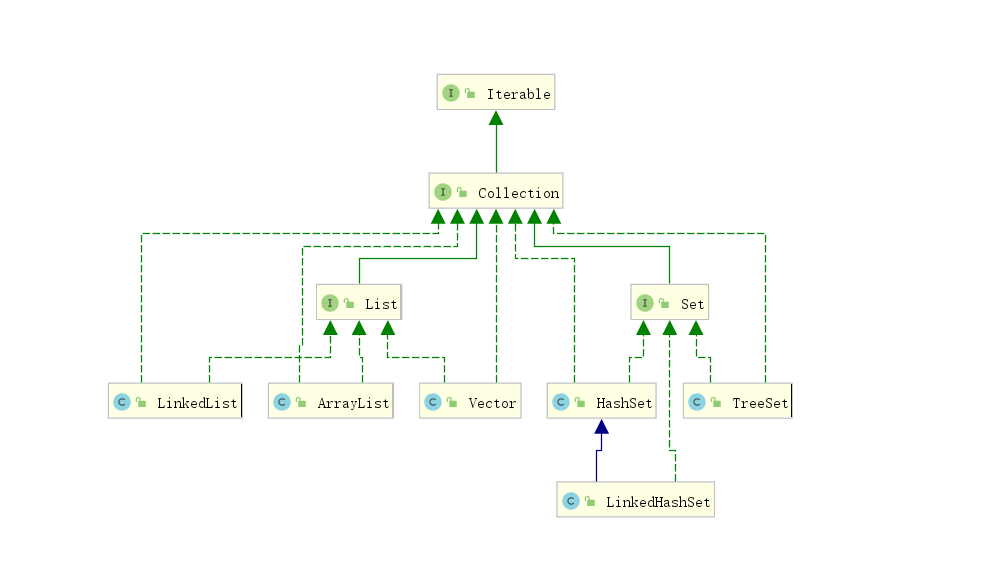Java | 集合(Collection)和迭代器(Iterator)
集合(Collection)
集合就是Java中提供的一种 空器,可以用来存储多个数据。
集合和数组都是一个容器,它们有什么区别呢?
- 数组的长度是固定的,集合的长度是可变的。
- 数组中存储的是同一类型的数据,并且也可以存储基本类型数据,但是集合中存储的都是对象,并且没有泛型的时候,还可以存储不同的对象。
Collection集合框架
Collection是一个集合类的顶级接口,所有的集合类的接口都是他的子类,或者实现类。

List接口:
1、在序的集合
2、允许存储生活重复的元素
3、有索引,可以使用普通的for循环遍历
set接口:
1、不允许有重复的元素
2、没有索引,不能进行普通的for循环
3、LinkedHashSet是有序的集合
Collection里面的方法
为什么要学习Collection里面的方法,是因为在用所有的Collection的实现类的时候,都可以用这些方法,所以学习这些方法就相当于学习了所有子类的方法,在以后学习子类方法的时候,只用学习一部分子类特有的就行了。
public boolean add(E e);把给定的对象添加到当前集合中
public void clear(E e);清空集合中所有的元素
public boolean remove(E e);把给定的对象在当前集合中删除
public boolean contains(E e);判断当前集合中是否包含给定对象
public boolean isEmpty();判断当前集合是否为空
public int size();返回集合中元素的个数
public Object[] toArray();把集合中的元素,存储到数组中
使用:
创建一个集合:
public boolean add(E e);` 把给定的对象添加到当前集合中
//使用多态
Collection<String> coll = new ArrayList<>();
coll.add("a");
coll.add("b");
coll.add("c");
coll.add("d");
//输出
System.out.println(coll); //[a, b, c, d]
public void clear(E e);清空集合中所有的元素
coll.clear();
System.out.println(coll); //[]
public boolean remove(E e);把给定的对象在当前集合中删除
coll.remove("a");
System.out.println(coll); //[b, c, d]
public boolean contains(E e);判断当前集合中是否包含给定对象
//包含返回true,没有返回false
System.out.println(coll.contains("c")); //true
public boolean isEmpty();判断当前集合是否为空
//判断当前集合是否为空,如果为空则为true,否则为false
System.out.println(coll.isEmpty()); //false
public int size();返回集合中元素的个数
System.out.println(coll.size()); //4
public T[] toArray(T[] a);把集合中的元素,存储到数组中
//创建一个数组,这个数组的长度就是集合的长度
String[] strArr = new String[coll.size()];
//然后把集合中的元素全都存到数组中
coll.toArray(strArr);
for (String s : strArr) {
System.out.println(s);
/* 循环输出:
a
b
c
d
*/
}
迭代器(Iterator)
我们在开发中经常需要遍厉集合,所以JDK专门提供了一个接口java.util.Iterator,这个接口的作用主要是用来迭代访问Collection中的元素的,所以换为迭代器。
迭代器(Iterator)的原理和使用
因为Collection继承了Iterator,所以可以使用Collection里面的iterator(),来获取迭代器。
最初的迭器的使用:
//使用多态
Collection<String> coll = new ArrayList<>();
coll.add("a");
coll.add("b");
coll.add("c");
coll.add("d");
System.out.println(coll); //[a, b, c, d]
//通过集合获取迭代器
Iterator<String> iterator = coll.iterator();
//用hasNext()方法来判断有没有下一个元素,如果有返回true
while (iterator.hasNext()) {
//用next()来获取下一个元素
//并且下标也移动到了当前元素下面,以方便上面的判断
String s = iterator.next();
System.out.println(s);
/* 迭代的结果:
a
b
c
d
*/
}
使用增强for循环:foreach来遍历集合,其实foreach里面也是使用Iterator来实现的。
for (String s : coll) {
System.out.println(s);
/* 循环的结果:
a
b
c
d
*/
}
使用Java8里面的新特性Lambda表达式循环集合,其实这个里面封装的是增强for循环。
coll.forEach(x -> System.out.println(x));
/* 循环的结果:
a
b
c
d
*/
forEach里面的方法:
default void forEach(Consumer<? super T> action) {
Objects.requireNonNull(action);
for (T t : this) {
action.accept(t);
}
}
这个方法是在Iterator里面,是一个默认方法,因为Collection继承了这个方法,所以可以使用这个方法。
集合工具(Collections)
java.utils.Collections集合工具类,就是用来简化对集合进行操作的。
常用的方法
pubic stativc <T> boolean addAll(Collection<T> c,T... elements);往集合中批量添加元素。public static void shuffle(List<?> list);乱序。public static <T> void sort(List<T> list);将集合中的元素按昭默认规则排序。public static <T> void sort(List<T> list, Comparator<? super T>);将集合中的元素按照指定规则进行排序。
使用
pubic stativc <T> boolean addAll(Collection<T> c,T... elements);往集合中批量添加元素。
List<String> list = new ArrayList<>();
Collections.addAll(list, "a", "b", "c", "d");
System.out.println(list); //[a, b, c, d]
public static void shuffle(List<?> list); 乱序。
List<String> list = new ArrayList<>();
Collections.addAll(list, "a", "b", "c", "d");
System.out.println(list); //[a, b, c, d]
Collections.shuffle(list);
System.out.println(list); //[d, b, a, c]随机的
public static <T> void sort(List<T> list); 将集合中的元素按昭默认规则排序。
List<String> list = new ArrayList<>();
//无序的
Collections.addAll(list, "b", "d", "g", "o");
Collections.sort(list);
System.out.println(list); //[b, d, g, o]
public static <T> void sort(List<T> list, Comparator<? super T>);将集合中的元素按照指定规则进行排序。
List<Integer> list = new ArrayList<>();
list.add(9);
list.add(3);
list.add(4);
list.add(2);
Collections.sort(list, new Comparator<Integer>() {
@Override
public int compare(Integer o1, Integer o2) {
//return o2 - o1; //[9, 4, 3, 2] 降序
return o1 - o2; //[2, 3, 4, 9] 升序
}
});
System.out.println(list);
关注公众号,随时获取最新资讯

细节决定成败!
个人愚见,如有不对,恳请斧正!


 浙公网安备 33010602011771号
浙公网安备 33010602011771号